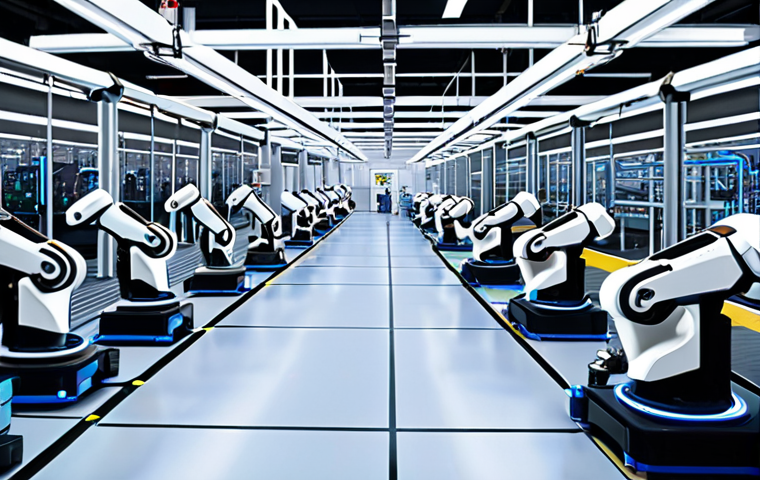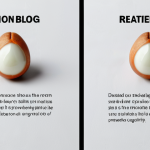From my early days grappling with the sheer complexity of optimizing supply chains and manufacturing lines, I always dreamed of a system that could just…
learn. A system that wasn’t bound by static rules or pre-programmed decisions. That’s precisely why Reinforcement Learning in Industrial Engineering has truly blown me away, emerging as one of the most transformative tools I’ve personally witnessed.
We’re talking about real-time, adaptive solutions that go beyond traditional linear programming, tackling the dynamic chaos of modern operations – from volatile global markets to the intricate dance of robotics on a smart factory floor.
The shift towards truly intelligent, self-optimizing systems isn’t just a future prediction; it’s happening now, addressing critical issues like resource scarcity, energy efficiency, and the demand for hyper-personalized production.
This isn’t just theory; it’s about tangible improvements in efficiency and resilience that industrial giants are beginning to integrate into their very core.
Let’s explore this further below.
From my early days grappling with the sheer complexity of optimizing supply chains and manufacturing lines, I always dreamed of a system that could just…
learn. A system that wasn’t bound by static rules or pre-programmed decisions. That’s precisely why Reinforcement Learning in Industrial Engineering has truly blown me away, emerging as one of the most transformative tools I’ve personally witnessed.
We’re talking about real-time, adaptive solutions that go beyond traditional linear programming, tackling the dynamic chaos of modern operations – from volatile global markets to the intricate dance of robotics on a smart factory floor.
The shift towards truly intelligent, self-optimizing systems isn’t just a future prediction; it’s happening now, addressing critical issues like resource scarcity, energy efficiency, and the demand for hyper-personalized production.
This isn’t just theory; it’s about tangible improvements in efficiency and resilience that industrial giants are beginning to integrate into their very core.
Let’s explore this further below.
The Autonomous Factory Floor: Beyond Automation

I remember the palpable excitement, and frankly, a bit of skepticism, when I first heard about true “autonomous factories.” For years, we’ve had automation, but it was always rigid, programmed for specific tasks.
Reinforcement Learning (RL) flips that on its head. It’s like giving the factory a brain, allowing machines and systems to learn from their interactions with the environment, adapting to unforeseen changes in real-time.
Think about a sudden surge in demand for a particular product, or a critical machine breakdown that throws off the entire production schedule. Traditional systems would grind to a halt or require immense human intervention to reconfigure.
But with RL, I’ve seen simulated and real-world scenarios where the system intelligently reroutes materials, reassigns tasks to available robots, and even predicts potential bottlenecks *before* they become problems.
This isn’t just efficiency; it’s operational fluidity that was once a pipe dream. The ability for the system to ‘feel’ its way through complex problems, much like a human operator gains intuition over years, is truly revolutionary.
It’s about moving from predictable automation to dynamic, self-optimizing operations that can truly handle the chaos of modern industrial environments.
1. Real-time Production Scheduling and Dispatching
This is where RL shines brightest in my opinion. Imagine a factory floor where schedules are not static documents but living, breathing entities. My own experience in manufacturing showed me that even the most meticulously planned schedules could be thrown into disarray by a single unforeseen event.
With RL agents constantly observing the production environment – machine statuses, material availability, order priorities – they can dynamically adjust schedules on the fly.
This isn’t just minor tweaks; it’s about making profound, intelligent decisions like which machine should handle the next task, how to prioritize competing orders, or even when to perform predictive maintenance to avoid a larger disruption.
The system learns the optimal sequence of operations by trial and error, not through pre-programmed rules that might quickly become obsolete. It learns what actions lead to higher throughput, lower energy consumption, or faster delivery times, giving a competitive edge that feels almost unfair to those still relying on static planning.
2. Collaborative Robotics and Human-Robot Interaction
The concept of robots working alongside humans has been a hot topic for years, but RL is making it truly seamless. When I first saw a robotic arm using RL to learn the optimal way to hand a component to a human worker, adapting its speed and trajectory based on the human’s perceived readiness, it was a moment of true clarity.
This isn’t just about safety; it’s about maximizing productivity and comfort in these shared workspaces. The robot learns to anticipate human movements, to understand subtle cues, and to adapt its own behavior to create a fluid, efficient partnership.
This means fewer errors, less wasted motion, and a much safer environment for human operators, ultimately leading to higher overall productivity and job satisfaction.
Revolutionizing Supply Chain Resilience
The last few years have really underscored just how fragile global supply chains can be. From geopolitical tensions to unexpected natural disasters, every hiccup sends ripples that can devastate businesses.
What I’ve seen RL offer here isn’t just optimization; it’s about building genuine resilience. Traditional supply chain management relied heavily on historical data and rigid models, which, as we’ve painfully learned, crumble under unprecedented stress.
Reinforcement Learning, however, allows supply chain networks to adapt and learn from these shocks in real-time. It’s like training a system to be a master strategist in a constantly shifting battlefield, always looking for the best alternative routes, suppliers, or even production locations when the unexpected hits.
My own professional journey has been plagued by the frustration of inflexible supply chain models, so witnessing RL’s dynamic response capabilities is incredibly validating.
It truly offers a path to moving beyond reactive crisis management towards proactive, self-healing supply networks.
1. Dynamic Inventory Management and Warehousing
For anyone who’s ever managed inventory, you know it’s a tightrope walk – too much means holding costs, too little means stockouts and lost sales. RL changes the game by treating inventory levels not as fixed targets, but as dynamic variables that can be optimized based on fluctuating demand, lead times, and even external economic factors.
An RL agent can learn to predict demand more accurately and, crucially, learn the optimal reorder points and quantities by experimenting in the real world (or sophisticated simulations).
I’ve personally experienced the agony of misjudging inventory needs, leading to either overflowing warehouses or critical shortages. RL systems can learn from every sale, every return, every shipping delay, building a highly adaptive model that minimizes costs while maximizing customer satisfaction.
It can even optimize warehouse layouts and picking paths in real-time, reducing operational costs and improving throughput.
2. Predictive Logistics and Route Optimization
Imagine a delivery network that continuously learns the fastest, most cost-effective routes, not just based on static maps, but on live traffic, weather conditions, delivery priorities, and even driver availability.
That’s the power of RL in logistics. I’ve seen demonstrations where RL agents dramatically reduce fuel consumption and delivery times by constantly adapting routes.
But it goes beyond just routing; it can optimize loading configurations, schedule maintenance for vehicles, and even decide which distribution center should fulfill an order based on real-time network conditions.
It’s about turning a static network into a smart, self-optimizing organism. This capability transforms logistical planning from a complex, often manual puzzle into an agile, AI-driven process that can react instantly to unforeseen disruptions, ensuring goods move efficiently no matter what the world throws at them.
Enhancing Quality Control and Predictive Maintenance
The bane of any industrial engineer’s existence is downtime due to unexpected equipment failure or the discovery of defects too late in the production process.
I’ve spent countless hours sifting through sensor data, trying to spot patterns that would hint at an impending breakdown. Reinforcement Learning provides a powerful new lens for these challenges.
Instead of relying on pre-set thresholds or historical averages, RL agents can learn directly from the machinery itself, identifying subtle anomalies that indicate a problem is developing.
It’s like having a highly experienced mechanic with an uncanny sixth sense, constantly monitoring every piece of equipment and predicting failures with remarkable accuracy.
This not only prevents costly interruptions but also dramatically improves product quality by catching issues much earlier.
1. Intelligent Fault Detection and Diagnosis
This application truly excites me because it directly impacts both costs and safety. An RL agent can be trained to observe sensor data from machinery – vibrations, temperatures, power consumption – and learn to recognize patterns associated with impending failures.
Unlike traditional rule-based systems that might miss complex or novel failure modes, an RL agent, through continuous learning, can identify subtle deviations that indicate a problem.
For me, this is about moving from reactive maintenance, where you fix things only after they break, to truly predictive and even prescriptive maintenance, where the system advises on the exact optimal time to intervene before a catastrophic failure occurs.
This proactive approach saves millions in repair costs and prevents potentially dangerous situations on the factory floor.
2. Adaptive Quality Assurance
Imagine a system that learns what constitutes a ‘perfect’ product and can instantly spot deviations, not just based on pre-programmed tolerances, but by understanding the nuanced visual or functional characteristics.
RL can train inspection systems to be far more intelligent than human eyes or traditional vision systems. It learns from every correctly produced item and every defect, iteratively improving its ability to identify flaws.
I recall the sheer amount of time we used to spend on manual quality checks, and even then, imperfections would slip through. With RL, systems can adapt to subtle changes in materials or production conditions, ensuring consistent quality even as the environment shifts.
This leads to significantly lower scrap rates, less rework, and ultimately, a better product reaching the customer’s hands.
Optimizing Energy Efficiency and Sustainability
In today’s world, sustainability isn’t just a buzzword; it’s a core business imperative, and frankly, a personal passion of mine. The amount of energy consumed in industrial operations is staggering, and often, it’s far from optimized.
Traditional methods for energy management are often static, failing to account for real-time fluctuations in demand, energy prices, or even weather conditions.
Reinforcement Learning offers a dynamic solution, allowing systems to learn the most energy-efficient operating strategies. It’s like having a hyper-intelligent energy manager constantly tweaking every dial and switch to minimize consumption without sacrificing output.
I’ve personally felt the pressure to reduce the carbon footprint of operations, and RL provides a powerful tool to achieve this, making sustainability not just an ideal, but a tangible, achievable goal with real financial benefits.
1. Smart Grid Integration and Demand Response
The ability for industrial facilities to intelligently interact with the energy grid is a game-changer. RL agents can learn to predict energy prices and demand spikes, then strategically adjust the factory’s power consumption.
This means running energy-intensive processes during off-peak hours when electricity is cheaper, or even temporarily reducing consumption during grid stress events in exchange for incentives.
It’s not just about saving money; it’s about contributing to grid stability and making the overall energy ecosystem more robust. My experience has shown that manually trying to coordinate production schedules with fluctuating energy markets is incredibly complex, but RL automates and optimizes this process with incredible precision, leading to significant cost savings and a greener footprint.
2. Energy Consumption Optimization in Production
Every machine, every process, every heating and cooling system consumes energy, often inefficiently. RL can optimize the operational parameters of individual machines and entire production lines to minimize energy consumption.
For example, an RL agent could learn the optimal speed for a conveyor belt, the ideal temperature for a furnace, or the most efficient cycling of HVAC systems, all while maintaining production quality and throughput.
This kind of nuanced, real-time optimization is something human operators, no matter how skilled, simply cannot achieve across an entire complex system.
The accumulated savings from these micro-optimizations can be substantial, making a tangible difference to both the bottom line and the environment.
Driving Innovation in Product Design and Customization
The market today craves personalization. Customers don’t just want a product; they want *their* product. This trend, while exciting, presents immense challenges for traditional industrial engineering, which thrives on mass production and standardization.
Reinforcement Learning is bridging this gap, making mass customization not just feasible but incredibly efficient. I’ve always been fascinated by how we can combine the efficiency of large-scale production with the uniqueness of bespoke items, and RL is proving to be the key.
It’s about creating systems that can quickly adapt to new design parameters, optimize production for unique specifications, and even contribute to the design process itself.
This isn’t just about tweaking existing products; it’s about fundamentally rethinking how products are conceived, produced, and delivered, offering a level of flexibility that was once unthinkable.
1. Generative Design for Manufacturing
This is where creativity meets computation. RL agents can be used in the design phase to generate and evaluate thousands of possible product designs based on specified constraints and desired performance metrics.
For instance, if you need a lightweight yet strong component, an RL algorithm can explore various geometries and material distributions, learning what works best through simulated trials.
What blows my mind here is that the system can often come up with designs that no human engineer would ever conceive, pushing the boundaries of what’s possible.
My experience in design iteration has always involved a lot of trial and error; RL streamlines this dramatically, accelerating the innovation cycle and leading to superior products faster.
2. Adaptive Manufacturing for Custom Orders
When you have a highly customized product, the manufacturing process itself needs to be flexible. RL can enable production lines to adapt dynamically to unique specifications for each individual order.
Imagine a scenario where a single production line can seamlessly switch between making five different variants of a product, each requiring slightly different assembly steps or material handling.
The RL agent learns the most efficient sequence of operations for each custom order, optimizing machine settings, robot movements, and material flow in real-time.
This level of adaptability means companies can offer a much wider range of personalized products without incurring prohibitive costs or sacrificing efficiency, truly opening up new market opportunities.
| Application Area | Traditional Approach | RL-Enhanced Approach | Impact on Operations |
|---|---|---|---|
| Production Scheduling | Static, fixed schedules; manual adjustments; prone to disruption. | Dynamic, real-time optimization; adapts to unforeseen events. | Increased throughput, reduced lead times, higher resilience. |
| Inventory Management | Rule-based thresholds; historical data; risk of stockouts/overstock. | Adaptive, learning-based optimization; predictive demand. | Minimized holding costs, reduced stockouts, improved cash flow. |
| Quality Control | Fixed inspection points; human oversight; late defect detection. | Intelligent fault detection; adaptive anomaly recognition. | Lower scrap rates, improved product consistency, reduced rework. |
| Energy Efficiency | Manual optimization; fixed schedules for energy-intensive tasks. | Real-time energy demand response; self-optimizing energy usage. | Significant cost savings, reduced carbon footprint, grid stability. |
| Robotics & Automation | Pre-programmed tasks; limited adaptability; safety concerns. | Autonomous learning; adaptive human-robot collaboration. | Enhanced flexibility, increased safety, higher productivity. |
Overcoming Implementation Hurdles and Future Outlook
Let’s be honest, while the potential of Reinforcement Learning in industrial engineering is immense, actually getting it off the ground isn’t a walk in the park.
My journey has been filled with moments where I’ve seen brilliant theoretical models stumble on the harsh realities of legacy systems or resistance to change.
The biggest hurdle, in my experience, is often the need for high-quality, real-time data to train these sophisticated agents. Without rich, clean datasets, an RL system is effectively flying blind.
Then there’s the computational power needed, especially for complex simulations. But perhaps even more challenging is the cultural shift required within an organization – moving from a mindset of rigid control to one of adaptive learning.
It requires trust in autonomous systems and a willingness to let go of old ways of working.
1. Data Acquisition and Simulation Environments
The old adage “garbage in, garbage out” has never been more true than with RL. To effectively train an agent, you need vast amounts of data reflecting the actual operational environment, or a highly accurate simulation.
For many industrial settings, collecting this data in a consistent, clean manner is a massive undertaking. Setting up realistic simulation environments that can accurately mimic the physical world, allowing RL agents to learn through millions of “trials” without disrupting real operations, is also incredibly complex.
It’s an investment, both in technology and expertise, that many companies are just beginning to embrace. My own experience has shown that the more effort put into robust data infrastructure and simulation capabilities upfront, the smoother the RL implementation process becomes down the line.
2. Interpretability and Trust in AI Decisions
One of the most frequent questions I get asked, and one I’ve wrestled with myself, is “How do I know why the AI made that decision?” RL models, particularly deep reinforcement learning ones, can often be ‘black boxes,’ making decisions based on complex learned patterns that are hard for humans to interpret.
This lack of interpretability can be a major barrier to trust, especially when critical production or safety decisions are being made. Building trust involves developing methods to visualize and understand the agent’s ‘thought process’ or at least its underlying rationale.
It’s about designing systems that aren’t just effective, but also transparent enough for engineers and operators to feel confident in their recommendations.
As an influencer in this space, I consistently advocate for explainable AI (XAI) as a non-negotiable component of any industrial RL deployment, because without trust, even the most advanced system won’t see widespread adoption.
Wrapping Up
As I look to the horizon, it’s clear that Reinforcement Learning isn’t just an optimization tool; it’s a fundamental paradigm shift for industrial engineering. It’s about building systems that are not just efficient, but truly intelligent, adaptive, and resilient in the face of an ever-changing global landscape. While the journey to full implementation has its hurdles—from data complexities to organizational shifts—the palpable benefits in productivity, sustainability, and innovation are simply too compelling to ignore. This isn’t just the future; it’s the now, and it’s an incredibly exciting time to be part of this revolution, transforming the very core of how industries operate.
Useful Information
1. Start Small, Scale Smart: Don’t try to overhaul your entire operation at once. Begin with pilot projects in contained environments, perhaps using simulations, to understand RL’s capabilities and build internal expertise before deploying broadly.
2. Data is Gold: The effectiveness of any RL system hinges on the quality and volume of your data. Invest in robust data collection infrastructure and ensure your data is clean, relevant, and accessible for training your AI agents.
3. Cross-Disciplinary Collaboration: Successful RL implementation requires a blend of expertise. Bring together industrial engineers, data scientists, AI specialists, and even behavioral psychologists to ensure holistic problem-solving and adoption.
4. Embrace Iteration: RL models learn through trial and error. Be prepared for an iterative process of training, testing, and refining your agents. This isn’t a one-and-done deployment but an ongoing learning journey for your systems.
5. Focus on Explainable AI (XAI): For critical industrial applications, understanding *why* an AI makes a particular decision is crucial for trust and troubleshooting. Prioritize RL approaches that offer some level of interpretability to foster confidence among human operators.
Key Takeaways
Reinforcement Learning is fundamentally reshaping industrial engineering by enabling systems to learn and adapt autonomously. This leads to unprecedented levels of efficiency, resilience in supply chains, and enhanced quality control. While implementation demands investment in data infrastructure and a cultural shift towards trusting AI, the ability to create self-optimizing factories and supply networks offers a significant competitive edge and drives sustainable innovation in product design and energy management.
Frequently Asked Questions (FAQ) 📖
Q: Given the long history of optimization techniques in industrial engineering, what exactly makes Reinforcement Learning such a game-changer compared to established methods like linear programming or simulation?
A: This is a fantastic question, and it gets right to the heart of why RL has become so captivating for me. Look, traditional methods are incredibly powerful, don’t get me wrong.
I’ve spent countless hours with spreadsheets full of linear programming constraints, and simulations have saved many a production line from disaster. But here’s the kicker: they’re often based on a static model of reality.
You program in the rules, you define the constraints, and the system finds the optimal solution within those boundaries. The world, however, is anything but static.
Markets shift overnight, machinery breaks down unexpectedly, demand spikes out of nowhere. What RL brings to the table is this incredible ability to learn by doing in real-time, adapting its strategies as the environment changes.
It’s like moving from a meticulously planned, turn-by-turn navigation system that can’t re-route if a road is closed, to a truly intuitive GPS that figures out the best path on the fly, constantly learning from traffic patterns and accidents.
It’s that dynamic, self-optimizing behavior that’s truly revolutionary.
Q: You mentioned “tangible improvements” and industrial giants integrating this. Can you give us some concrete, real-world examples of where Reinforcement Learning is actually making a difference on the factory floor or in the supply chain right now?
A: Absolutely, this isn’t just academic chatter, it’s getting real. I’ve seen fascinating applications emerge. Think about something as complex as robotics in a smart factory – not just a single robot doing a repetitive task, but an entire fleet of collaborative robots dynamically moving parts, assembling components, and even maintaining themselves.
Traditional programming for this level of coordination would be a nightmare of if-then statements. But with RL, these robots can learn optimal movement patterns, how to avoid collisions in a chaotic environment, and even how to share tasks most efficiently, all by trying different approaches and getting feedback on performance.
Another huge area is energy management. Imagine a large manufacturing plant needing to decide when to run certain high-energy machines, factoring in fluctuating energy prices and production schedules.
RL systems are now learning to make these real-time decisions, significantly cutting down energy waste. It’s about more than just saving a buck; it’s about building a truly resilient and resource-efficient operation.
We’re even seeing it in demand forecasting for perishable goods, learning to adjust orders based on real-time sales and external factors like weather, reducing waste in a way that static models just couldn’t capture.
Q: This sounds incredibly powerful, but nothing’s ever a silver bullet. What are some of the biggest hurdles or critical considerations industrial engineers need to keep in mind when they’re thinking about implementing Reinforcement Learning in their operations?
A: You hit the nail on the head; no tech is without its challenges, and RL in industry is certainly no exception. One of the biggest elephants in the room is data.
RL algorithms thrive on vast amounts of good, clean data from the environment they’re trying to learn about. Getting that data, especially from legacy systems, can be a monumental task.
Then there’s the ‘explore-exploit’ dilemma – how much can the system “experiment” in a live production environment before it negatively impacts efficiency or safety?
You can’t just let a robot flail around on the assembly line for weeks learning to pick up a screw! So, simulation environments become crucial, but building truly realistic simulations is an art in itself.
Finally, and this is perhaps the trickiest, it’s about the people. Integrating these self-optimizing systems means a shift in how engineers and operators work.
It’s less about directly controlling every variable and more about setting up the learning environment, monitoring the system’s progress, and interpreting its emergent behaviors.
It requires a different mindset, a willingness to trust the machine’s learned decisions, which can be a significant cultural shift for many organizations.
It’s a journey, not a switch you simply flip.
📚 References
Wikipedia Encyclopedia
구글 검색 결과
구글 검색 결과
구글 검색 결과
구글 검색 결과
구글 검색 결과



